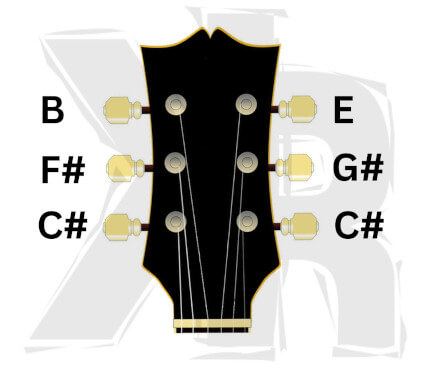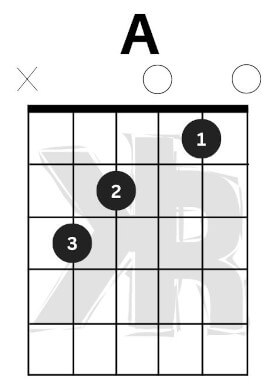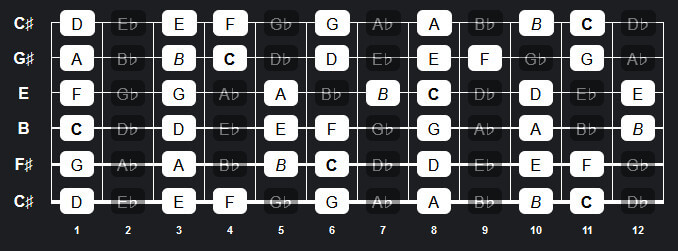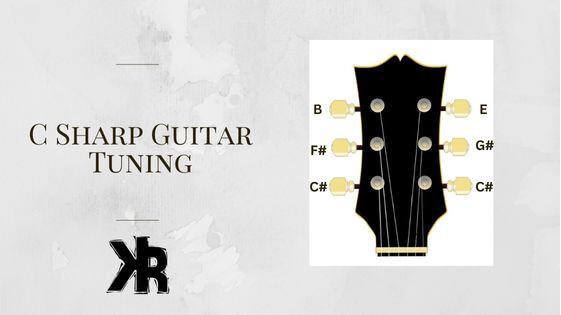Table of Contents
If you are wondering how to tune a guitar to C sharp standard, there are a few different ways that you can do so. But first, you might be wondering what C Sharp standard guitar tuning really is.
C sharp tuning is an alternate arrangement for a 6-string guitar. It’s achieved by tuning your guitar one and a half steps down from standard. When done properly, your strings will be tuned to C#, F#, B, E, G#, and C#.
In this Killer Rig article, we will explore how to tune to C sharp standard, as well as where it’s used and how it can benefit you as a musician. We will also explore a few tips, as your guitar might not be able to handle this lower tuning.
Make sure to check out our other tuning guides:
C Sharp Tuning For Guitar
The most popular way to tune to C sharp is by using a digital guitar tuner. This can be done by plugging into a tuner, or by using an app on your phone.
If you’re using a physical tuner, the needle will indicate which string is out of tune and how far off it is. You can then adjust the pitch of the string until the needle is in the middle.
If you’re using an app, it will usually show you a graphic representation of a guitar fretboard. You can then drag your finger along the screen to the note you’re tuned to. C sharp is obtained by tuning each string down one and a half steps from standard.
Once you have your guitar in C sharp tuning, there are a few things you can do to check that it’s in tune. The first is to play an open C chord and then strum all the strings. If it sounds good, then your guitar is in tune.
The second way to check if your guitar is in tune is by using a reference note. For this, you’ll need another instrument that you know is in tune, such as a piano. Find a note on the piano that’s in the same pitch as your open C string.
Then, play the note on the piano and compare it to the sound of your guitar string. If they sound the same, then your guitar is in tune.
C# Standard Tuning String Notes

Most players will be in standard tuning when they begin to look into C#. Standard tuning is E, A, D, G, B, and E. Starting from the thickest to thinner string. From this point, each string will need to be tuned down a step. Then one more half-step.
- Tune your thick E string down to C#.
- A string down to F#.
- D String down to B.
- G-string down to E.
- B string, tuned down to G#.
- And E string down to C#.
Use your tuner to bring them down one at a time. Once they are close, fine-tune them once more. Just in case of any changes to your guitar when dropping the strings down to their new arrangement.
How To Use C Sharp Tuning
C sharp tuning can be used for a variety of different styles of music. It’s commonly used in rock and metal, as well as in blues and jazz. It’s used because of its thicker and warmer sound. For aggressive styles of music, the deep, heavy tone is quite popular.
It closely resembles standard tuning, except that the pitch is different. As a result, so are the notes. You can still use the same chord shapes as you would with standard tuning. But they will now be associated with a different note. Here is an example:

In standard tuning, this chord would be known as a C. But when tuned to C sharp, it becomes an A.
If you’re a beginner, C sharp tuning is a great way to start using an alternate arrangement. It’s also a good tuning to use if you’re a lead guitarist, as it allows you to play solos in the key of C sharp.
If you’re a rhythm guitarist, using C sharp tuning can add a new dimension to your playing. It can also make it easier to transition between chords and melodies.
C sharp tuning is also great for improvisation. By being able to play in different keys. You’ll be able to create more interesting solos and chord progressions. Here is a diagram of the notes along the fretboard:

C Sharp Tuning For Bass Guitar
C sharp tuning can also be used for bass guitar. To tune your bass to C sharp, you’ll need to lower the pitch of your strings in the same manner. The standard tuning for a 4-string bass guitar is E, A, D, and G.
This will need to be lowered by one and a half steps to C#, F#, B, and E. Do this in the same manner, first by one step per string. Then, one more half-step.
Just like with the 6-string guitar, there are a few ways that you can check if your bass is in tune. You can use a physical or digital guitar tuner. Or you can compare the sound of your bass guitar to another instrument that’s in tune.
Once you have your bass in C sharp tuning, you’ll be able to play a variety of different styles of music.

C Sharp Tuning Songs
Many artists and bands use this guitar tuning because of its sound. Some popular songs that use C# tuning are:
- Conquer All – Behemoth.
- Feel Good Hit of the Summer – Queens of the Stone Age.
- Minus Human – Metallica.
- Second and Sebring – Of Mice and Men.
- We’re an American Band – Rob Zombie.
- Krwlng – Linkin Park.
If you prefer a different tuning, we have a bunch of Drop C songs here!
Additional Tips
Some guitars might struggle with this lower tuning. If you find that your strings are buzzing and just don’t play right, there are a few things you can do.
- Use a thicker string gauge, we recommend no less than 10-52.
- You may want to adjust your action.
- Check your bridge and adjust the height.
Once properly set up with a heavier string gauge, most guitars have no problems with C sharp tuning. When in doubt, contact a good guitar technician for help.
FAQs
Is Db tuning the same as C sharp?
Yes, Db tuning is the same as C sharp standard. They are both one and a half steps lower than standard tuning.
How do I tune my guitar to C sharp?
To tune your guitar to C sharp, you’ll need to lower the pitch of each string by one and a half steps. You can use a digital guitar tuner, or you can compare the sound to another instrument that’s in tune.
Is C sharp tuning good for beginners?
Yes, C sharp tuning is a good arrangement for beginners. It’s a good way to start learning how to tune your guitar. It’s also a great tuning to use to experiment with new sounds and songs.

